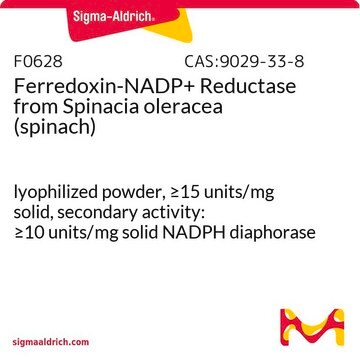F3629
Ammonium iron(III) sulfate dodecahydrate
ReagentPlus®, ≥99%
Synonyme(s) :
Ammonium iron disulfate dodecahydrate, Ammonium ferric sulfate dodecahydrate
About This Item
Produits recommandés
Niveau de qualité
Gamme de produits
ReagentPlus®
Essai
≥99%
Pertinence de la réaction
core: iron
reagent type: catalyst
Pf
39-41 °C (lit.)
Température de stockage
2-8°C
Chaîne SMILES
N.O.O.O.O.O.O.O.O.O.O.O.O.[Fe+3].OS([O-])(=O)=O.[O-]S([O-])(=O)=O
InChI
1S/Fe.H3N.2H2O4S.12H2O/c;;2*1-5(2,3)4;;;;;;;;;;;;/h;1H3;2*(H2,1,2,3,4);12*1H2/q+3;;;;;;;;;;;;;;;/p-3
Clé InChI
LCPUDZUWZDSKMX-UHFFFAOYSA-K
Vous recherchez des produits similaires ? Visite Guide de comparaison des produits
Application
- A catalyst to synthesize 1,4-dihydropyridines via one-pot three-component condensation reaction of dimedone, aldehydes, and 3-aminocrotonate in ethanol.
- An additive in the reduction of aromatic nitro compounds to the corresponding amino compounds in the presence of alumina-supported hydrazine hydrate as a catalyst.
Informations légales
Vous ne trouvez pas le bon produit ?
Essayez notre Outil de sélection de produits.
Mention d'avertissement
Danger
Mentions de danger
Conseils de prudence
Classification des risques
Eye Dam. 1
Code de la classe de stockage
13 - Non Combustible Solids
Classe de danger pour l'eau (WGK)
WGK 1
Point d'éclair (°F)
Not applicable
Point d'éclair (°C)
Not applicable
Équipement de protection individuelle
dust mask type N95 (US), Eyeshields, Gloves
Faites votre choix parmi les versions les plus récentes :
Déjà en possession de ce produit ?
Retrouvez la documentation relative aux produits que vous avez récemment achetés dans la Bibliothèque de documents.
Les clients ont également consulté
Notre équipe de scientifiques dispose d'une expérience dans tous les secteurs de la recherche, notamment en sciences de la vie, science des matériaux, synthèse chimique, chromatographie, analyse et dans de nombreux autres domaines..
Contacter notre Service technique











